A Study of Landscape Features in the Coastal Area of the Seto Inland Sea Based on Landscape Paintings
Abstract
1. Introduction
2. Materials and Methods
2.1. Seto Inland Sea Area and Landscape Paintings
2.2. Element Configuration Features
2.3. Color Features
2.3.1. Histogram Data
2.3.2. Histogram Similarity
2.4. Element Arrangement Features
2.5. Comprehensive Similarity Features and Classification
3. Results
3.1. Element Configuration Features
3.2. Color Features
3.3. Element Arrangement Features
3.4. Comprehensive Similarity and Classification
4. Discussion
5. Conclusions
- We comprehensively clarified the general and typical landscape features in the coastal area of the Seto Inland Sea, and more landscape information was extracted to better present the features of a “good and characteristic landscape”, which can provide more comprehensive guidance and data for the subsequent landscape planning work and analysis in this area;
- We presented a simple and feasible method to classify landscape paintings by comminating the similarities of three aspect features. The method proposed a practical idea that can flexibly combine the features or other indicators from different attribution depending on the actual application and the research purpose;
- Sky, Green, and Sea were the most essential elements of the painting. In addition, the Sky element was almost always depicted at the top part of the image, and Green and Sea elements were less depicted and were more evenly distributed in the image, of which the Sea element was more inclined to be depicted in the middle and bottom parts of the painting;
- Yellow (orange), green and blue were commonly used in target paintings. In addition, paintings were usually painted in medium and low saturation, as well as medium and high brightness. The yellow and green with medium saturation and brightness were mostly presented in landscape paintings in the coastal area of the Seto Inland Sea.
- The 62 paintings were classified into eight types; they were: (1) Architecture landscape (eight paintings), (2) Pond/River landscape (six paintings), (3) Nearshore landscape (four paintings), (4) Field landscape in green hue (six paintings), (5) Field landscape in yellow and orange hue (six paintings), (6) Green Seaside landscape (thirteen paintings), (7) Island and boat landscape (fourteen paintings), and (8) Seaside landscape in sunset (sun raise) period (fourteen paintings).
Author Contributions
Funding
Institutional Review Board Statement
Informed Consent Statement
Data Availability Statement
Conflicts of Interest
Appendix A
| No. | Name | Author | Published Year | From |
|---|---|---|---|---|
| 1 | Naruto | Gentaro KOITO | 1952 | Tokushima Modern Art Museum. https://art.bunmori.tokushima.jp/srch/srch_art_sakka.php/ (accessed on 12 March 2018) |
| 2 | Sunrise of Mt. Goken | Takeji FUJISHIMA | 1932 | Bridgestone Museum of Art fiftieth anniversary celebration Fujishima Takeji [27] |
| 3 | Sunrise of Mt Goken | Takeji FUJISHIMA | 1932 | Ehime Prefectural Museum Collection 2010 [28] |
| 4 | Sunset of Uwa Sea | Yonezo SHIBATA | 1977 | Shibata Yonezo Art Album [29] |
| 5 | Kotohiragu | Tatsushiro TAKABATAKE | 1953 | Tokushima Modern Art Museum https://art.bunmori.tokushima.jp/srch/srch_art_sakka.php/ (accessed on 12 March 2018) |
| 6 | Near Nakagi Island | Hitone NOMA | 1967 | Ehime Prefectural Museum Collection 2010 [28] |
| 7 | Wilderness | Wasaku KOBAYASHI | 1959 | Wasaku Kobayashi Art Book [30] |
| 8 | Sadamisama | Wasaku KOBAYASHI | 1959 | Wasaku Kobayashi Art Book [30] |
| 9 | Seaside | Wasaku KOBAYASHI | 1959 | Tenchi Hourei Wasaku Kobayashi Art Book [31] |
| 10 | Spring of Shodo Island | Takeji FUJISHIMA | 1936 | Bridgestone Museum of Art fiftieth anniversary celebration Fujishima Takeji [27] |
| 11 | Returning Sail from Tesuki Island | Kunishiro MITSUTANI | 1932 | Tokushima Modern Art Museum https://art.bunmori.tokushima.jp/srch/srch_art_sakka.php/ (accessed on 12 March 2018) |
| 12 | View of Mt. Shima | Hitone NOMA | unknown | Tokushima Modern Art Museum https://art.bunmori.tokushima.jp/srch/srch_art_sakka.php/ (accessed on 12 March 2018) |
| 13 | Sakate Port | Kakutaro KASHIWABARA | unknown | The Kagawa Museum art collection catalog [32] |
| 14 | Kuribayashi Park | Toshio NAKANISHI | 1936 | Tokushima Modern Art Museum https://art.bunmori.tokushima.jp/srch/srch_art_sakka.php/ (accessed on 12 March 2018) |
| 15 | Takamatsu City | Mitsuyuki NAKAMURA | 1979 | The Kagawa Museum art collection catalog [32] |
| 16 | Manno Pond | Yoshisumi KONISHI | 1990 | The Kagawa Museum art collection catalog [32] |
| 17 | Manno Pond | Yoshisumi KONISHI | 1995 | The Kagawa Museum art collection catalog [32] |
| 18 | Manno Pond | Yoshisumi KONISHI | 1998 | The Kagawa Museum art collection catalog [32] |
| 19 | Manno Pond | Yoshisumi KONISHI | 1990 | The Kagawa Museum art collection catalog [32] |
| 20 | Manno Pond | Yoshisumi KONISHI | 2001 | The Kagawa Museum art collection catalog [32] |
| 21 | Mount Iino | Norimasa AMAMIYA | 1981 | The Kagawa Museum art collection catalog [32] |
| 22 | Sakaide Harbor Scenery | Chutsu IMANISHI | unknown | Tokushima Modern Art Museum https://art.bunmori.tokushima.jp/srch/srch_art_sakka.php/ (accessed on 12 March 2018) |
| 23 | From Megi Island to Look Over Nao Island | Shintaro YAMASHITA | 1934 | Tokushima Modern Art Museum https://art.bunmori.tokushima.jp/srch/srch_art_sakka.php/ (accessed on 12 March 2018) |
| 24 | Ya Island | Ken KAGEYAMA | unknown | The Kagawa Museum art collection catalog [32] |
| 25 | Zentsuji Temple | Masajiro KAWAZOE | 1980 | The Kagawa Museum art collection catalog [32] |
| 26 | Copper Refinery in Nao Island | Shigeyoshi KAWAHITO | 1980 | The Kagawa Museum art collection catalog [32] |
| 27 | Oil Storage in Shodo Island | Hirokatsu KINOSHITA | 1980 | The Kagawa Museum art collection catalog [32] |
| 28 | Otomon of Marugame Castle | Shoroku KOBAYASHI | 1982 | The Kagawa Museum art collection catalog [32] |
| 29 | Mt. Goken | Asaji SAITO | 1979 | The Kagawa Museum art collection catalog [32] |
| 30 | Seto Island in Summer | Heizo KANAYAMA | 1916 | The National Museum of Modern Art https://www.momat.go.jp/collection/ (accessed on 9 April 2018) |
| 31 | Shioe Hot Spring Village | Sadao TOMIIE | 1981 | The Kagawa Museum art collection catalog [32] |
| 32 | Inokuma Residence | Eisuke NAKAMURA | 1979 | The Kagawa Museum art collection catalog [32] |
| 33 | Inogono Pass in Autumn | Yoshimori FUNAOKA | 1980 | The Kagawa Museum art collection catalog [32] |
| 34 | Tsushima | Ra MUKAI | unknown | The Kagawa Museum art collection catalog [32] |
| 35 | Kanamaluza | Takayoshi OKADA | unknown | The Kagawa Museum art collection catalog [32] |
| 36 | Scenery of Seto Island Sea in Early Summer | Kakutaro KASHIWABARA | 1974 | The Kagawa Museum art collection catalog [32] |
| 37 | View from Ya Island | Takeji FUJISHIMA | 1932 | Tokushima Modern Art Museum https://art.bunmori.tokushima.jp/srch/srch_art_sakka.php/ (accessed on 12 March 2018) |
| 38 | View from Ya Island | Takeji FUJISHIMA | 1932 | Tokushima Modern Art Museum https://art.bunmori.tokushima.jp/srch/srch_art_sakka.php/ (accessed on 12 March 2018) |
| 39 | Summer | Torajiro KOJIMA | 1913 | Landscape paintings of Chugoku region--From Setouchi to Sanin area [33] |
| 40 | Onomichi Scenery | Shimizu TOSHI | 1933 | Landscape paintings of Chugoku region-From Setouchi to Sanin area [33] |
| 41 | Kamikiri Island Scenery | Minami KUNZO | 1949 | Landscape paintings of Chugoku region-From Setouchi to Sanin area [33] |
| 42 | Aki Seashore | Minami KUNZO | unknown | Landscape paintings of Chugoku region-From Setouchi to Sanin area [33] |
| 43 | Structures Along the River | Ishii HAKUTEI | 1927 | Landscape paintings of Chugoku region-From Setouchi to Sanin area [33] |
| 44 | Itsuku Island | Tokusaburo MASAMUNE | unknown | Landscape paintings of Chugoku region-From Setouchi to Sanin area [33] |
| 45 | Itsuku Island | Shintaro SUZUKI | 1953 | Landscape paintings of Chugoku region-From Setouchi to Sanin area [33] |
| 46 | Mount Taika | Ebihara KINOSUKE | 1953 | Landscape paintings of Chugoku region-From Setouchi to Sanin area [33] |
| 47 | Olives and Sea | Toku SATAKE | 1965 | Landscape paintings of Chugoku region-From Setouchi to Sanin area [33] |
| 48 | Lighthouse | Shiyohei MATSUDA | 1959 | Landscape paintings of Chugoku region-From Setouchi to Sanin area [33] |
| 49 | Dannoura | Ishikawa TORAJI | 1963 | Landscape paintings of Chugoku region-From Setouchi to Sanin area [33] |
| 50 | Mt. Naki | Atsushiro KOBAYAKAWA | 1951 | Landscape paintings of Chugoku region-From Setouchi to Sanin area [33] |
| 51 | Mt. Akikame | Kunitaro SUDA | unknown | Landscape paintings of Chugoku region-From Setouchi to Sanin area [33] |
| 52 | Kaminoa Island | Hiroshi YOSHIDA | 1930 | Landscape paintings of Chugoku region-From Setouchi to Sanin area [33] |
| 53 | Shirashi Island | Hiroshi YOSHIDA | 1922 | Landscape paintings of Chugoku region-From Setouchi to Sanin area [33] |
| 54 | Tomo Harbor | Hiroshi YOSHIDA | 1930 | Landscape paintings of Chugoku region-From Setouchi to Sanin area [33] |
| 55 | Plum | Wasaku KOBAYASHI | 1935 | Wasaku Kobayashi Art Book [30] |
| 56 | Island of Spring | Wasaku KOBAYASHI | unknown | Wasaku Kobayashi Art Book [30] |
| 57 | The Sea in Springtime | Wasaku KOBAYASHI | 1974 | Wasaku Kobayashi Art Book [30] |
| 58 | Sensui Island | Torajiro KOJIMA | 1917 | Landscape paintings of Chugoku region-From Setouchi to Sanin area [33] |
| 59 | Landscape of Island | Wasaku KOBAYASHI | unknown | Tenchi Hourei Wasaku Kobayashi Art Book [31] |
| 60 | Tomotu Fish Market Times | Kunishiro MITSUTANI | unknown | Landscape paintings of Chugoku region-From Setouchi to Sanin area [33] |
| 61 | Cloudy Day of Harbor | Yoson IKEDA | 1914 | Landscape paintings of Chugoku region-From Setouchi to Sanin area [33] |
| 62 | Moring of Sensui Island | Umehara RYUZABURO | 1932 | Landscape paintings of Chugoku region-From Setouchi to Sanin area [33] |
References
- Basic Principles of the Landscape Law (Enacted in 2004): A Good Landscape is Formed by Harmonizing People’s Lives, Economic Activities, etc., including “National Assets Shared by the People” and “Regional Nature, History, Culture, etc.”, “Closely Related to the Unique Characteristics of the Region”, “Contributing to the Revitalization of the Region”, “including Not Only Conservation but Also New Creation”. Available online: https://www.mlit.go.jp/toshi/keikanhou.html (accessed on 12 November 2017).
- Hagishima, S.; Ohgai, A.; Kim, J.; Sugahara, T.I.Y. A Study of the Urban Landscape in the 19C European Landscape Paintings. J. Archit. Plan. Res. Stud. 1990, 413, 83–93. [Google Scholar]
- Hagishima, S. Study on Urban Landscape Paintings-19th Century European Impressionist Urban Landscape; Kyushu University Publishing Company: Fukuoka, Japan, 2002. [Google Scholar]
- Sakai, T.; Deguchi, A.; Hagishima, S.; Park, J.; Sugahara, T. A study on the Landscape Classification in the UKIYOE Paintings of Hiroshige. J. Archit. Plan. Res. Stud. 1994, 461, 165–174. [Google Scholar] [CrossRef]
- Shimizu, R.; Sakai, T.; Deguchi, A. Method for Seeking Viewpoints Based on Composition of Moon Landscape in Hiroshige’s Ukiyoe Paintings. J. Archit. Plan. Res. Stud. 2009, 635, 161–168. [Google Scholar] [CrossRef]
- Iwasaki, M.; Shimizu, S. Landscape Evaluation of Bridges in Ukiyoe-With Fractal Dimension. Trans. Jpn. Soc. Kansei Eng. 2010, 9, 519–529. [Google Scholar] [CrossRef]
- Ogawa, Y.; Zhao, S. Study on Viewpoint Estimation of Urban Landscape Painting Using Camera Calibration (Landscape Structure/View Landscape, Urban Planning); Summaries of technical papers of academic conferences-Housing Issues 2011; Architectural Institute of Japan: Tokyo, Japan, 2011; pp. 243–244. [Google Scholar]
- Sakai, T.; Hagishima, S.; Deguchi, A.; Ikaruga, S.; Hitaka, K. Composition of Townscape in the UKIYOE Paintings. Archit. Plan. Res. Stud. 1998, 509, 149–156. [Google Scholar] [CrossRef] [PubMed]
- Ikeda, T.; Ohgai, A. Image of Landscape and Their Transitions in Akutagawa Prize Works from 1970 to 1994. Archit. Plan. Res. Stud. 1997, 494, 161–168. [Google Scholar] [CrossRef] [PubMed]
- Yabe, T.; Kitahara, T.; Tokuyama, I. A Study on the Japanese Local Landscape Image of the School Songs. Archit. Plan. Res. Stud. 1995, 472, 111–122. [Google Scholar] [CrossRef] [PubMed]
- Higuchi, T. The Visual and the Spatial Structure of Landscape; Gihodo Shuppan Company: Tokyo, Japan, 1975; p. 61. [Google Scholar]
- Qiao, T.; Zhang, W.; Zhang, M.; Ma, Z.; Xu, D. Ancient painting to natural image: A new solution for painting processing. In Proceedings of the 2019 IEEE Winter Conference on Applications of Computer Vision (WACV), Waikoloa, HI, USA, 7–11 January 2019; IEEE: Piscataway, NJ, USA, 2019; pp. 521–530. [Google Scholar]
- Hughe, J.M.; Graham, D.J.; Rockmore D, N. Quantification of artistic style through sparse coding analysis in the drawings of Pieter Bruegel the Elder. Proc. Natl. Acad. Sci. USA 2010, 107, 1279–1283. [Google Scholar] [CrossRef] [PubMed]
- Wu, J.; Wu, J.; Lin, P.H. Research on the Audience’s Cognition and Preference of the Styles of Chinese Landscape Paintings. In Proceedings of the Cross-Cultural Design. Methods, Tools and User Experience: 11th International Conference, CCD 2019, Held as Part of the 21st HCI International Conference, HCII 2019, Orlando, FL, USA, 26–31 July 2019; Springer International Publishing: Berlin/Heidelberg, Germany, 2019; pp. 215–225. [Google Scholar]
- Agarwal, S.; Karnick, H.; Pant, N.; Patel, U. Genre and style- based painting classification. In Proceedings of the 2015 IEEE Winter Conference on Applications of Computer Vision, Waikoloa, HI, USA, 5–9 January 2015; IEEE: Piscataway, NJ, USA, 2015; pp. 588–594. [Google Scholar]
- Choi, Y.Y.; Lee, H.S. A Development of Biophilic Color Palette Based on ‘Monet’s Landscape Painting. J. Archit. Inst. Korea 2021, 37, 13–24. [Google Scholar]
- Lee, B.; Seo, M.K.; Kim, D.; Shin, I.S.; Schich, M.; Jeong, H.; Han, S.K. Dissecting landscape art history with information theory. Proc. Natl. Acad. Sci. USA 2020, 117, 26580–26590. [Google Scholar] [CrossRef] [PubMed]
- Habin, L.; Reynolds, J.F. A Simulation Experiment to Quantify Spatial Heterogeneity in Categorical Maps. Ecology 1994, 75, 2446–2455. [Google Scholar]
- Murtagh, F.; Contreras, P. Algorithms for hierarchical clustering: An overview. Wiley Interdiscip. Rev. Data Min. Knowl. Discov. 2012, 2, 86–97. [Google Scholar] [CrossRef]
- Nishida, M. Changes in fixed sights and tourist spots in the Seto Inland Sea. Landsc. Res. 1998, 61, 395–400. [Google Scholar] [CrossRef]
- Iwamoto, A.; Ikaruga, S.; Kobayashi, T. Visual Feature of “PICTURESQUE LANDSCAPE” in the Coast of Seto Inland Sea. In Proceedings of the 10th International Symposium on City Planning and Environment Management in Asian Countries, Makassar, Indonesia, 9–11 January 2016. [Google Scholar]
- Zhang, Y.; Zhao, S. Landscape characteristic and utilization method of “PICTURESQUE LANDSCAPE” in the coast area of Seto Inland Sea. J. Archit. Plan. Res. Stud. 2023, 88, 580–591. [Google Scholar] [CrossRef]
- Maxwell, J.C. On the Theory of Compound Colors, and the Relations of the Colors of the Spectrum. Philos. Trans. R. Soc. Lond. 1860, 150, 57–84. [Google Scholar]
- Kartika, D.S.Y.; Herumurti, D.; Yuniart, I.A. Butterfly image classification using color quantization method on hsv color space and local binary pattern. In Proceedings of the 3rd International Seminar on Science and Technology, Surabaya, Indonesia, 3 August 2017; pp. 78–82. [Google Scholar]
- Mutlag, W.K.; Ali, S.K.; Aydam, Z.M.; Taher, B.H. Feature Extraction Methods: A Review. In Journal of Physics: Conference Series; IOP Publishing: Bristol, UK, 2020; Volume 1591, p. 012028. [Google Scholar]
- Li, G.; Liu, W.; Cao, L. An Image Retrieval Method Based on Color Perceived Feature. J. Image Graph. 1999, 4, 248–251. [Google Scholar]
- Kaizuka, T.; Nakata, H.; Ueno, K. Bridgestone Museum of Art Fiftieth Anniversary Celebration Fujishima Takeji; Bridgestone Museum of Art, Ishibashi Foundation: Tokyo, Japan, 2002. [Google Scholar]
- Ehime Prefectural Museum. Ehime Prefectural Museum Collection 2010; Friends of the Ehime Museum of Art: Matsuyama, Japan, 2010. [Google Scholar]
- Shibata, Y. Shibata Yonezo Art Book; Kyuryudo Art Publishing: Tokyo, Japan, 1980. [Google Scholar]
- Kobayashi, W. Wasaku Kobayashi Art Book.; The Asahi Shimbun Company: Tokyo, Japan, 1978. [Google Scholar]
- Kobayashi, W. Tenchi Hourei Kazu Kobayashi Art Book; Kyuryudo Art Publishing: Tokyo, Japan, 1974. [Google Scholar]
- Kagawa Prefectural Museum. The Kagawa Museum Art Collection Catalogue; Kagawa Prefectural Museum: Kagawa, Japan, 2015. [Google Scholar]
- Hiroshima Prefectural Museum. Landscape Paintings of Chugoku Region-from Setouchi to Sanin Area; Chugoku Shimbun Company: Hiroshima, Japan, 1992. [Google Scholar]
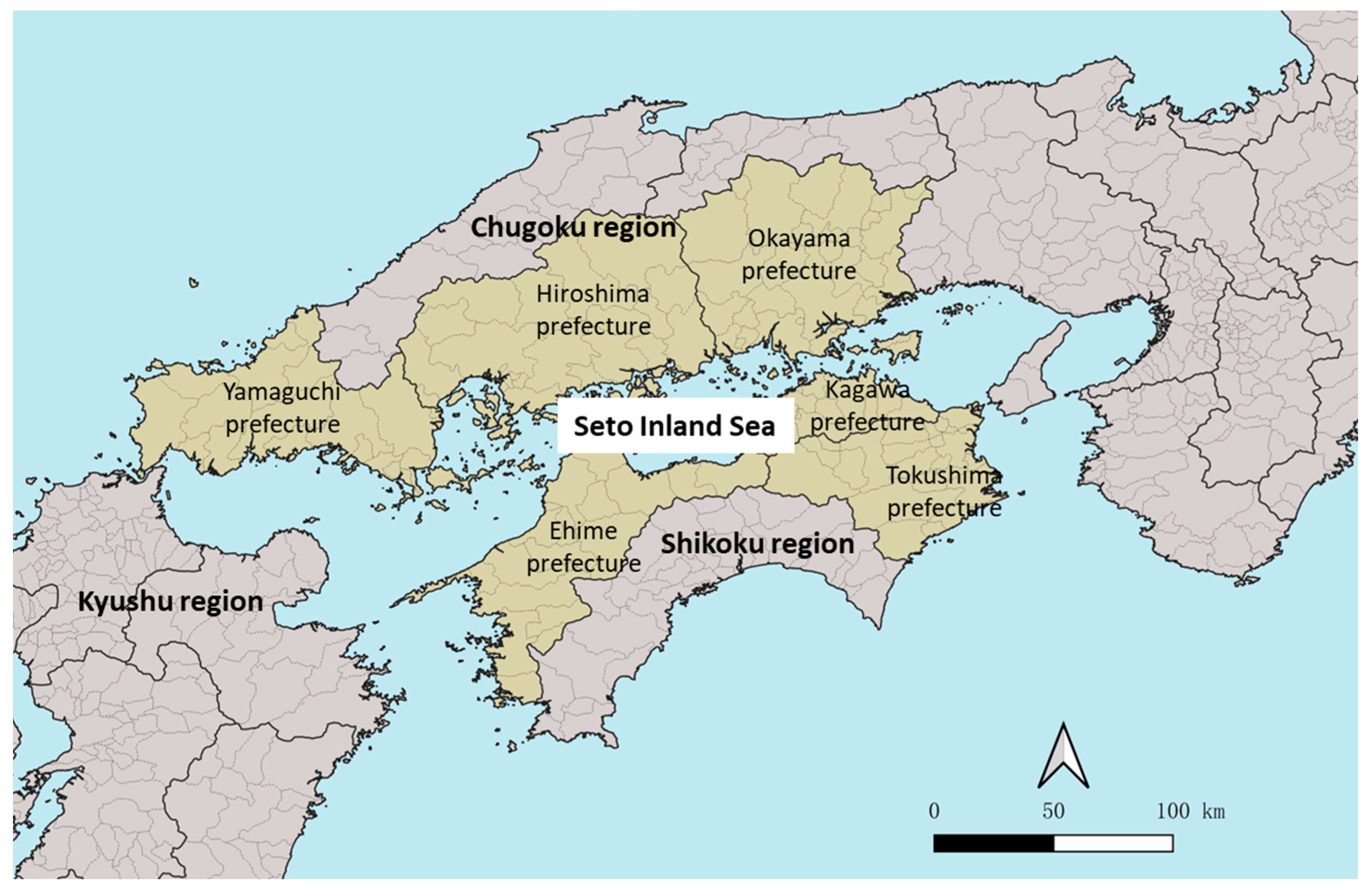



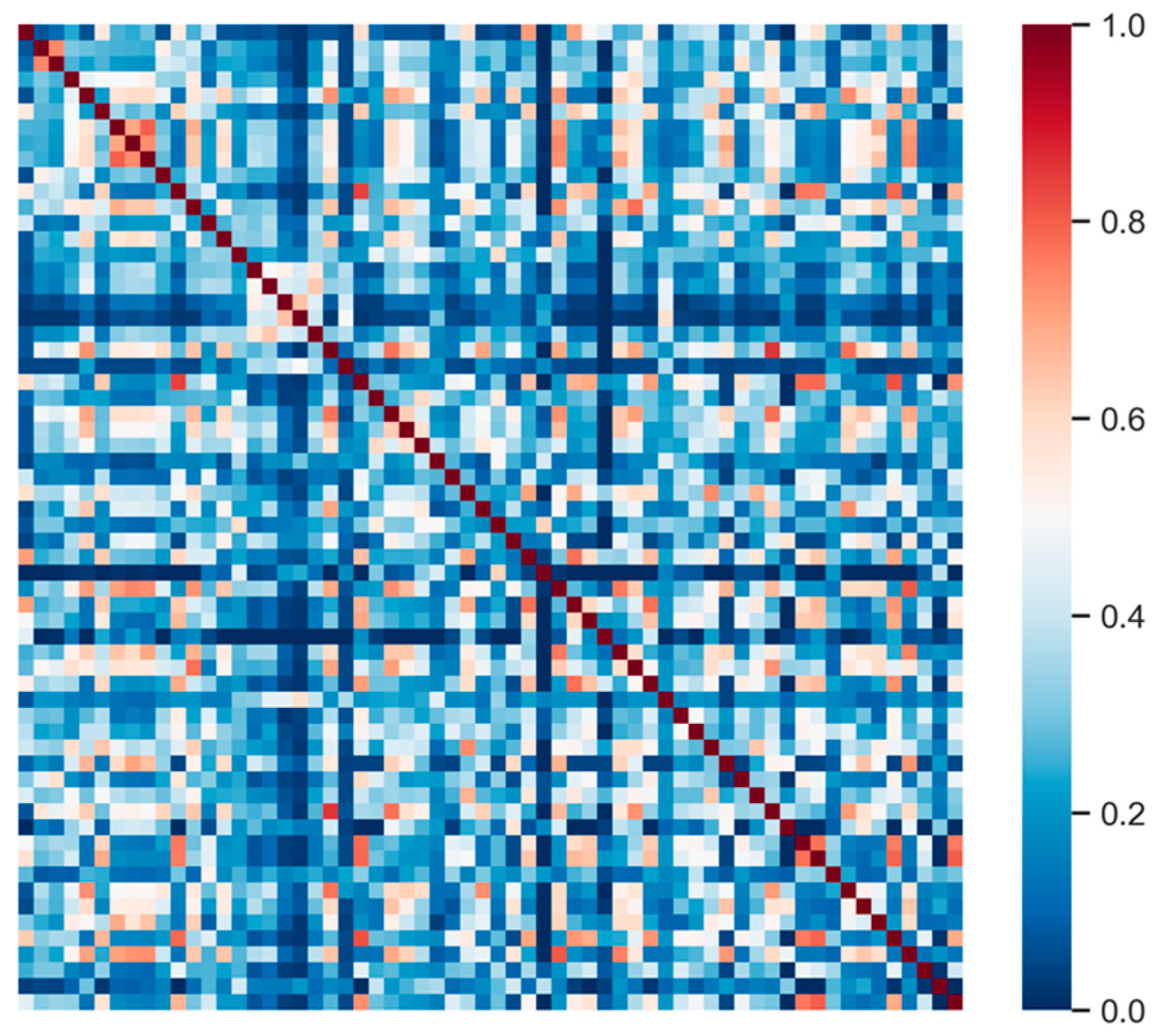

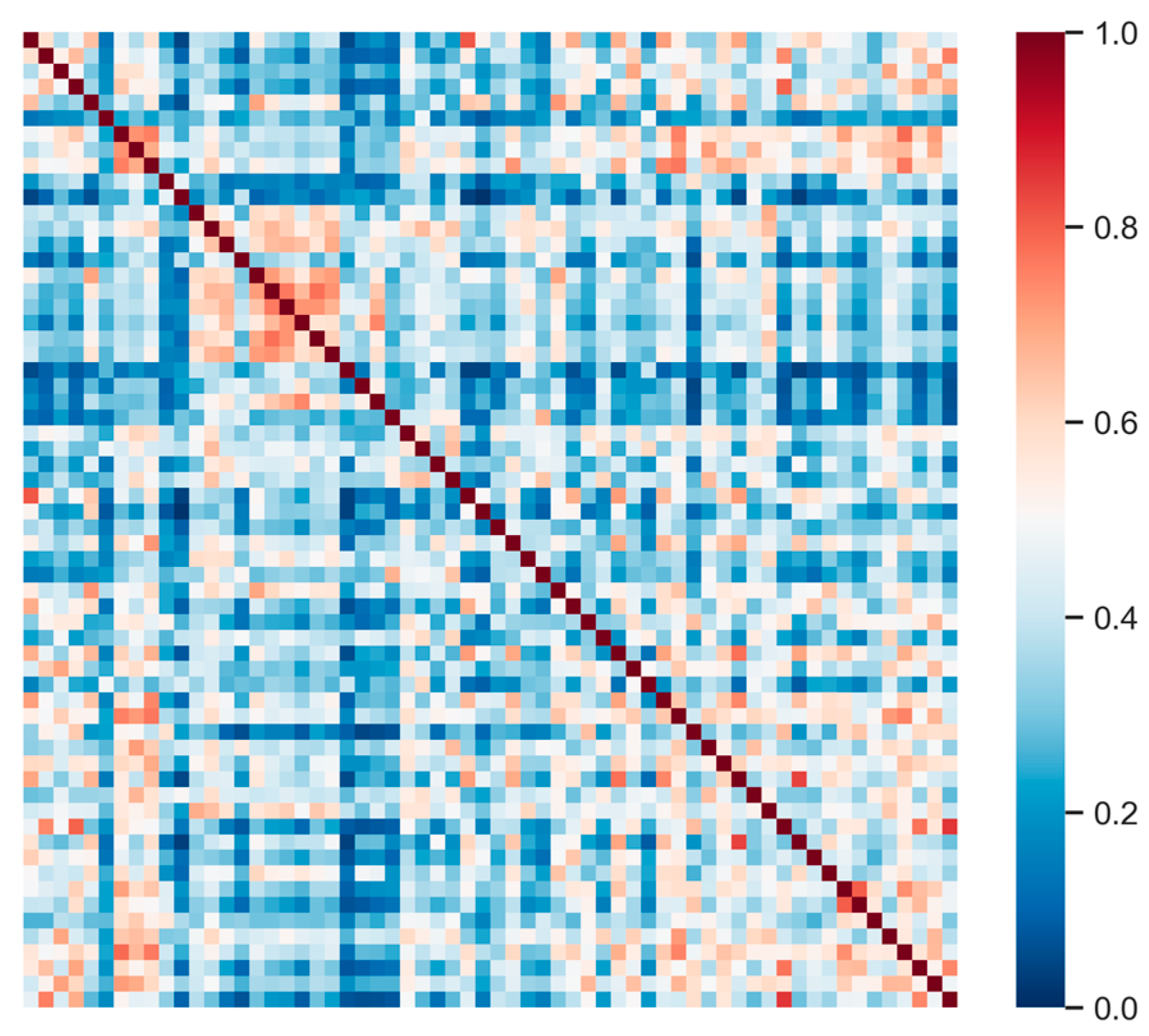
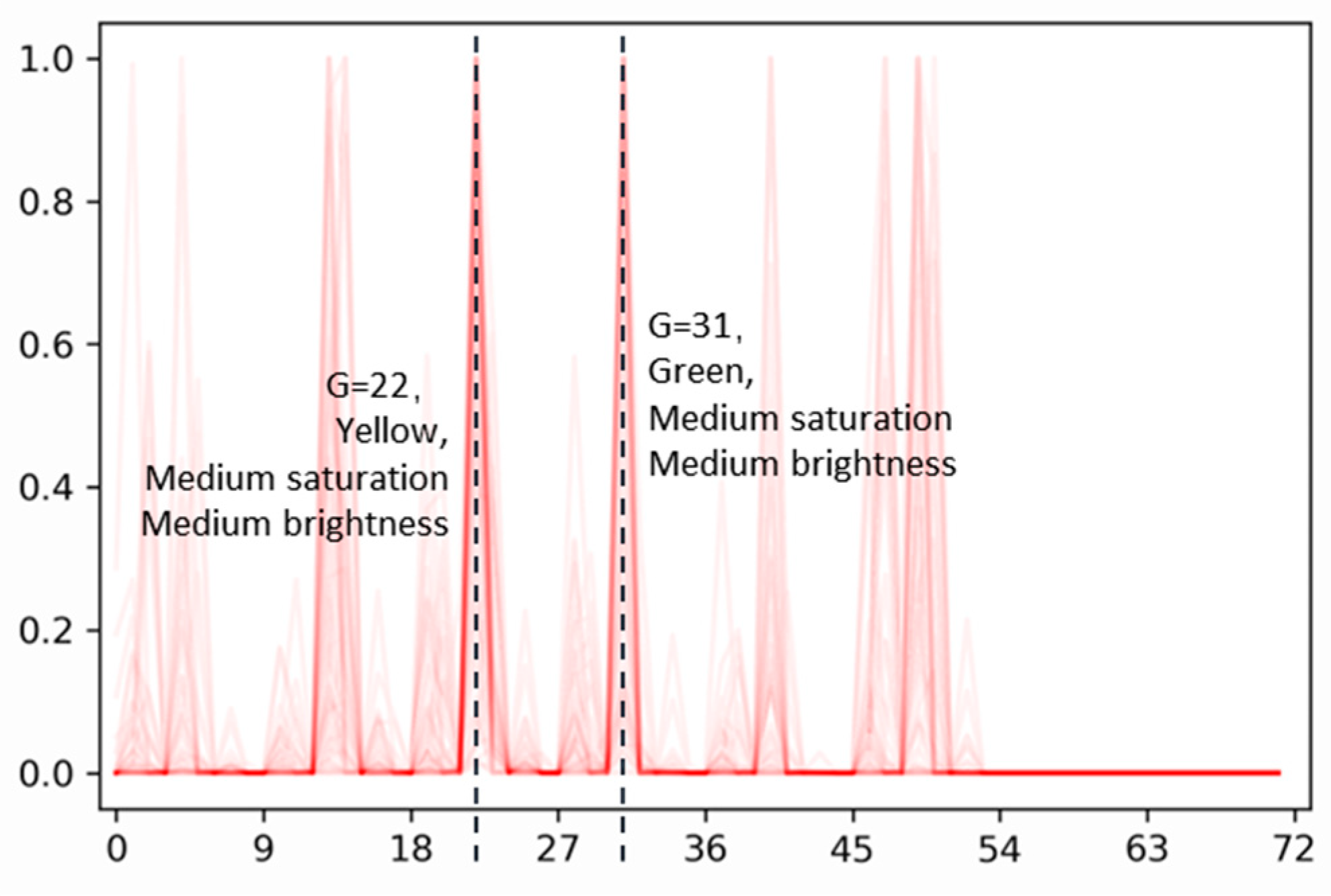

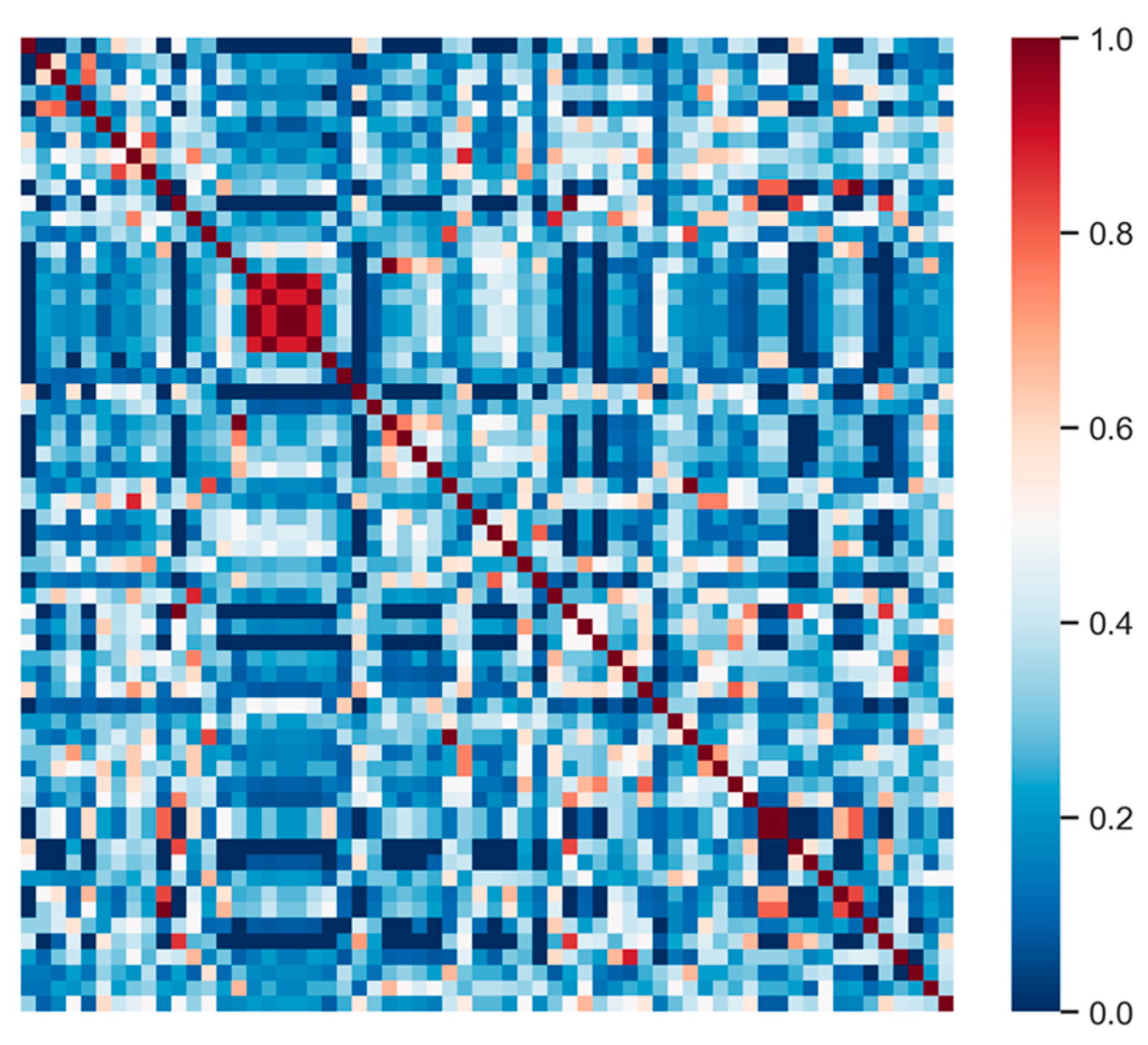
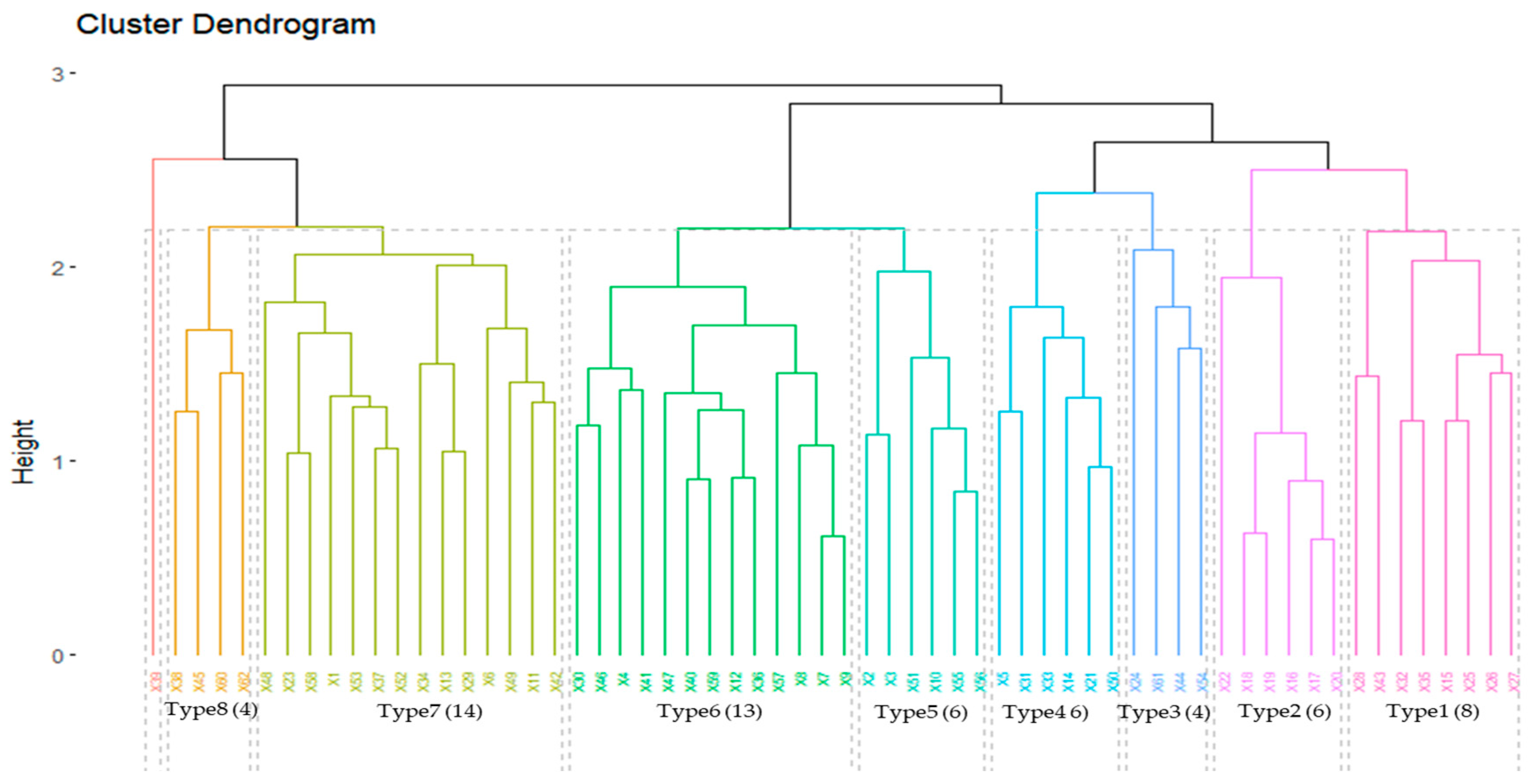
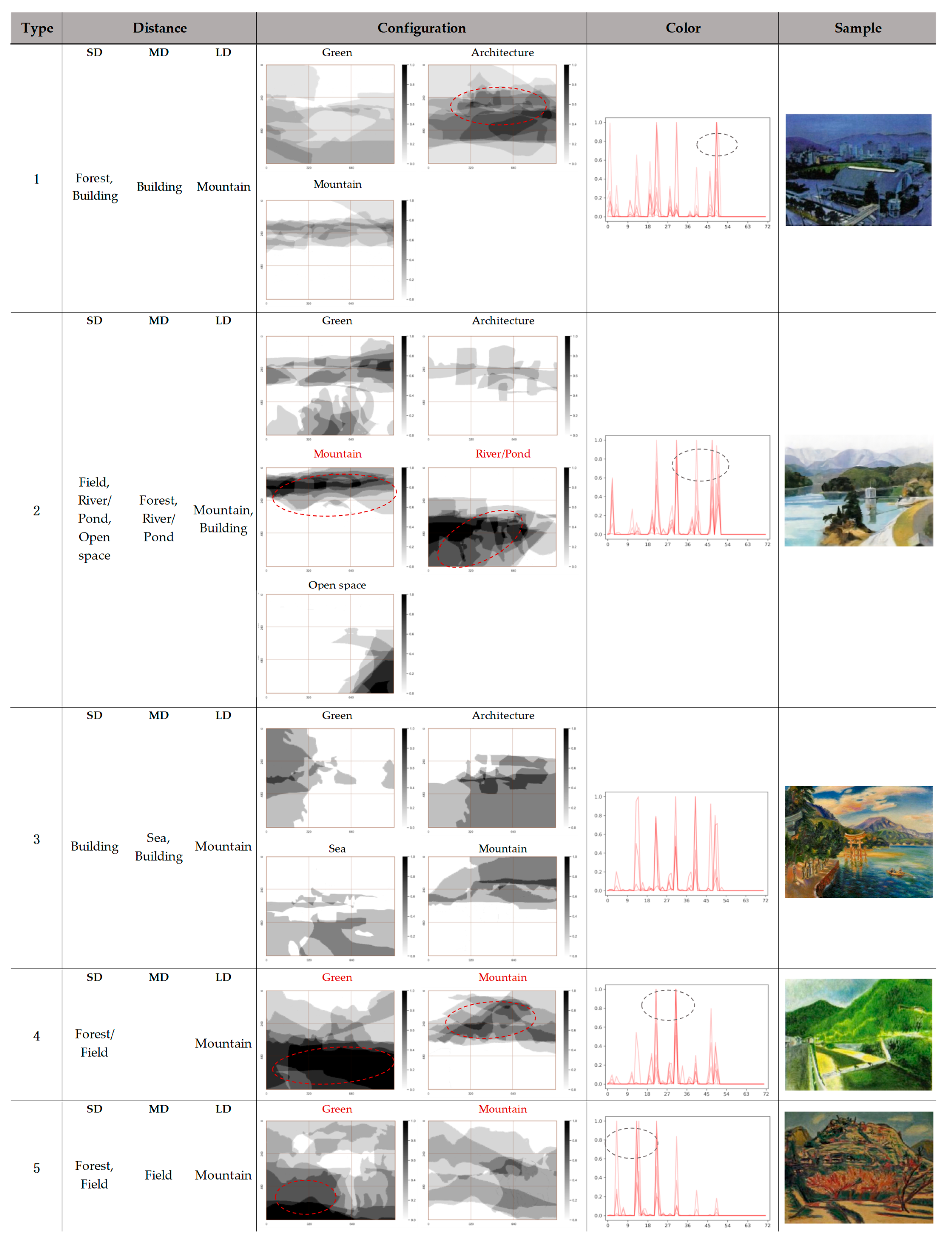
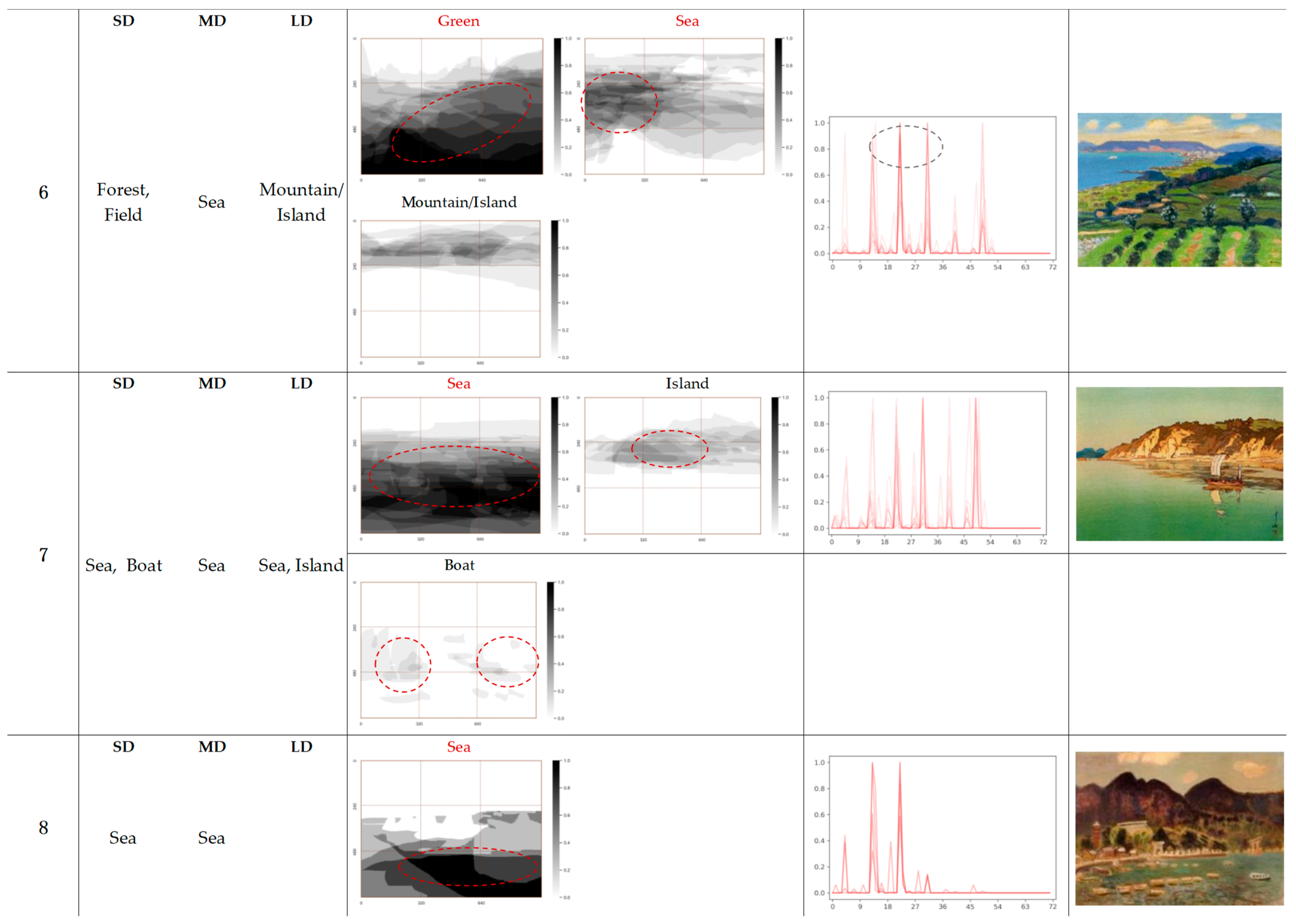
| Attribution | Number | Range | Presentation |
|---|---|---|---|
| H | 0 | (316, 20] | Red, Black, White |
| 1 | (20, 40] | Orange | |
| 2 | (40, 75] | Yellow | |
| 3 | (75, 155] | Green | |
| 4 | (155, 190] | Cyan | |
| 5 | (190, 270] | Blue | |
| 6 | (270, 295] | Purple | |
| 7 | (295, 316] | Red | |
| S | 0 | [0, 0.2) | Low |
| 1 | [0.2, 0.7) | Medium | |
| 2 | [0.7, 1] | High | |
| V | 0 | [0, 0.2) | Low |
| 1 | [0.2, 0.7) | Medium | |
| 2 | [0.7, 1] | High | |
| G = 9H + 3S + V (0~71) | |||
| Distance | Landscape Category | Case Number | Proportion |
|---|---|---|---|
| Short distance | Forest/Tree | 27 | 43.55% |
| Field/Grass | 30 | 48.39% | |
| River/Pond | 8 | 12.90% | |
| Sea/Harbor | 24 | 38.71% | |
| Boat | 14 | 22.58% | |
| Building | 14 | 22.58% | |
| Road/Open space | 11 | 17.74% | |
| Medium distance | Mountain | 10 | 16.13% |
| Forest/Tree | 18 | 29.03% | |
| Field/Grass | 12 | 19.35% | |
| River/Pond | 7 | 11.29% | |
| Sea/Harbor | 35 | 56.45% | |
| Island | 11 | 17.74% | |
| Boat | 13 | 20.97% | |
| Building | 29 | 46.77% | |
| Bridge | 8 | 12.90% | |
| Long distance | Mountain | 50 | 80.65% |
| Sea | 23 | 37.10% | |
| Island | 24 | 38.71% |
Disclaimer/Publisher’s Note: The statements, opinions and data contained in all publications are solely those of the individual author(s) and contributor(s) and not of MDPI and/or the editor(s). MDPI and/or the editor(s) disclaim responsibility for any injury to people or property resulting from any ideas, methods, instructions or products referred to in the content. |
© 2023 by the authors. Licensee MDPI, Basel, Switzerland. This article is an open access article distributed under the terms and conditions of the Creative Commons Attribution (CC BY) license (https://creativecommons.org/licenses/by/4.0/).
Share and Cite
Zhang, Y.; Zhao, S. A Study of Landscape Features in the Coastal Area of the Seto Inland Sea Based on Landscape Paintings. Int. J. Environ. Res. Public Health 2023, 20, 6165. https://doi.org/10.3390/ijerph20126165
Zhang Y, Zhao S. A Study of Landscape Features in the Coastal Area of the Seto Inland Sea Based on Landscape Paintings. International Journal of Environmental Research and Public Health. 2023; 20(12):6165. https://doi.org/10.3390/ijerph20126165
Chicago/Turabian StyleZhang, Yichuan, and Shichen Zhao. 2023. "A Study of Landscape Features in the Coastal Area of the Seto Inland Sea Based on Landscape Paintings" International Journal of Environmental Research and Public Health 20, no. 12: 6165. https://doi.org/10.3390/ijerph20126165
APA StyleZhang, Y., & Zhao, S. (2023). A Study of Landscape Features in the Coastal Area of the Seto Inland Sea Based on Landscape Paintings. International Journal of Environmental Research and Public Health, 20(12), 6165. https://doi.org/10.3390/ijerph20126165





